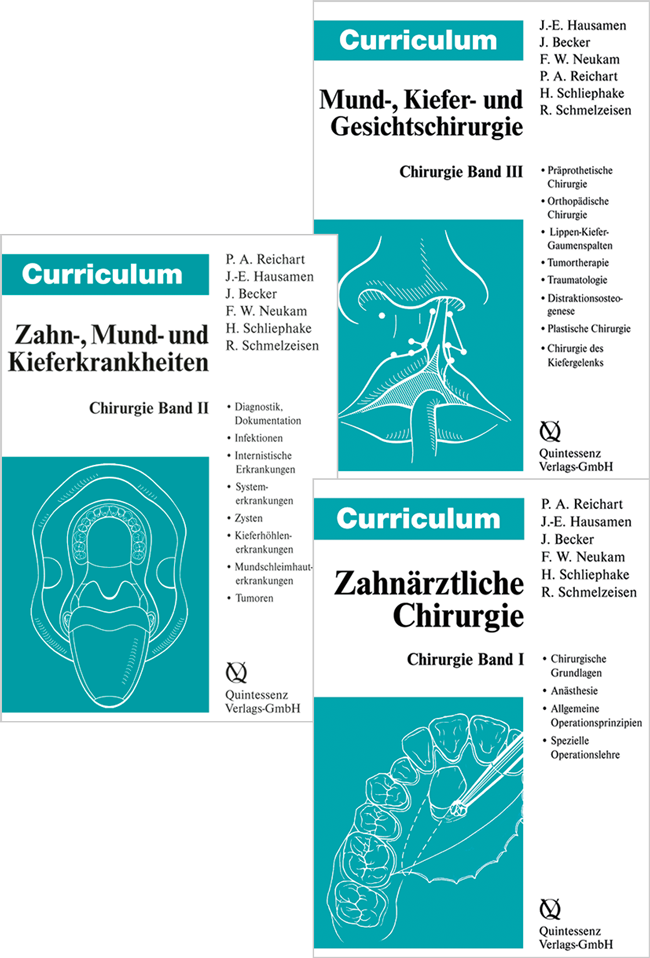International Poster Journal of Dentistry and Oral Medicine, 4/2004
Poster 245, Sprache: DeutschKüttner, Christian/Brachvogel, Peter/Hausamen, Jarg-Erich/Schwestka-Polly, Rainer/Lisson, Jörg A.Das Kinnprofil stellt einen bedeutenden Teilaspekt eines harmonischen Gesichtes dar. Die meisten ästhetischen Störungen im Bereich der Kinnregion treten im Zusammenhang mit skelettalen Dysgnathien auf. In der Regel läßt sich heute durch ein kombiniertes orthodontisch-chirurgisches Behandlungskonzept eine zufriedenstellende Verbesserung des Kinnprofiles erreichen.
Die Auswertung eines Kollektives von 1564 kombiniert behandelten Dysgnathiepatienten zeigt ein umgekehrt proportionales Verhältnis zwischen der Anzahl von bignathen Umstellungsosteotomien und sekundären Kinnplastiken. Zu Beginn der noch verhältnismäßig jungen Disziplin 'orthopädische Gesichtschirurgie' stand zunächst die Harmonisierung der Kieferbasen im Zentrum der Operationsplanung. Häufig wurde dann eine monognathe Umstellungsosteotomie vorgennommen und sekundär die Kinnregion korregiert. Heute berücksichtigen die modernen Behandlungskonzepte schon primär die Profilpla-nung, was an einem höheren Anteil bignather Umstellungsosteotomien deutlich wird. Erst die komplette Mobilisierung von Ober- und Unterkiefer im Rahmen eines bignathen Eingriffes erlaubt nahezu jede skelettale Position von Ober- und Unterkiefer dreidimensional und gesichtsschädelbezogen einzustellen. Die Neben einer eugnathen Verzahnung läßt sich so, unabhängig von der Ausgangsdysgnathie, nahezu jedes gewünschte Profilbild erzielen. Zusätzliche ästhetische Indikationen zur operativen Kinnkorrektur ergeben sich nur noch selten.
Das Ziel der Untersuchung war es, die Indikationen zur zusätzlichen Kinnkorrektur mit Hilfe der FRS-Analyse zu erarbeiten.
Schlagwörter: Dysgnathie, orthopädische Gesichtschirurgie, Kinnplastik, Umstellungsosteotomie
Quintessenz Zahnmedizin, 3/2004
Oralchirurgie / Orale MedizinSeiten: 229-235, Sprache: DeutschKüttner, Christian/Claar, Michael/Hausamen, Jarg-ErichDas Frontzahntrauma zählt zu den wenigen Notfällen in der zahnärztlichen Praxis, deren Behandlung absolute Dringlichkeit verlangt. Vorgestellt wird eine spezielle Schienungstechnik unter Verwendung eines Draht-Meshs. Gegenüber den herkömmlichen Verfahren liegen die Vorteile der Draht-Mesh-Technik in der Möglichkeit der unmittelbaren Fixierung (chairside) der geschädigten Zähne in physiologischer Position (dynamische Immobilisation). Die Okklusion und die Artikulation werden nicht beeinträchtigt. Auch im Wechselgebiss ist diese Schienungsmethode gut einsetzbar. Nach Abschluss der Schienungsphase kann das Draht-Mesh leicht und atraumatisch entfernt werden.
Schlagwörter: Frontzahntrauma, dentale Schienung, Draht-Mesh
International Poster Journal of Dentistry and Oral Medicine, 1/2003
Poster 160, Sprache: DeutschKüttner, Christian/Samii, M./Hausamen, Jarg-ErichTeratomas are rare tumors of childhood with an incidence between 1:20.000 to 1:40.000 births. 5% of those teratomas are located in the head and neck region. Without treatment 80% of the little patients with oropharyngeal teratomas die in the postpartum period because of airway obstruction. The treatment of oropharyngeal teratoma, especially when extended to intracranial cavity, remains very difficult. Establishment of a secure airway is the most important step after delivery. The complete surgical resection has to be performed without creating significant growth impairment. A case of a female patient with an intracranial extended oropharyngeal teratoma is presented. A lateral transmandibular approach to the scull base with temporal exarticulation of the mandible was used for final tumor resection. 6 years after surgery there were no neurological deficits but hemimandibular microsomia treated successfully with distraction ostegenesis. The technical aspects of the surgical technique used are demonstrated and treatment modalities of oropharyngeal teratomas are described.
Schlagwörter: Teratom, Kleinkind, Schädelbasis, transmandibulärer Zugang, Distraktionsosteogenese, Unterkiefer
International Poster Journal of Dentistry and Oral Medicine, 4/2002
Poster 148, Sprache: DeutschKüttner, Christian/Schönweiler, Rainer/Schirdewan, Britta/Dempf, Rupert/Hausamen, Jarg-Erich/Ptok, MartinThere is still a controversy regarding the timing of repair of the deformities associated with cleft lip and palate (CLP). At Hannover Medical School 417 patients underwent primary palatoplasty and veloplasty at 24-30 months of age from 1985 to 1993. This study gives a premilary report of the long-term speech and language outcome of this collective. 30 patients were randomly selected and a retrospective evaluation of data collected from 1985 to 2000 was performed summarizing receptive and expressive speech and language skills. In a prospective evaluation those probands were reexamined (mean 13 years after palatoplasty) and the nasalance was determined with NasalViewTM. The materials used were the vowels /a:/, /e:/, /i:/, /o:/, /u:/, the sentences S1 'Die Schokolade ist sehr lecker' ('This chocolate is tasty') and S2 'Nenne meine Mamma Mimmi' ('Call my mum Mimmi'), and the text passages of LT1 'Nordwind und Sonne' 'Northwind and Sun'), LT2 'Kindergeburtstag' ('A childs birthday party') and LT3 'Der große Gesang' ('A famous song'). As a control-group 20 healthy children of the same age were selected. The median age was 14 years (range from 11 to 19 years). 27 patients (90%) did not feel any handicap, while 3 patients (10%) described little impairment. The mean nasalance for the vowels, for S1 (containing no nasal consonants), for LT2 (with many nasal sounds) and for LT3 was significantally higher than the mean nasalance of the control-group. For S2 and for LT1 there were no differances to the control. The clinical implications of these results were discussed and it is suggested that an earlier closure of the palate will lead to better functional results in CLP patients.
Schlagwörter: nasalance, nasality, cleft lip and palate, velopharyngeal incompetence, velopharyngeal insufficiency
International Poster Journal of Dentistry and Oral Medicine, 4/2002
Poster 149, Sprache: EnglischKüttner, Christian/Hausamen, Jarg-Erich/Dempf, Rupert/Brachvogel, PeterThe choice of surgical approach to tumors of the cranial base in children is determined by strict criteria. These include optimal visibility for the surgeon, a minimum possible impairment of facial skull growth and the preservation of motor and sensory nerve integrity. From 1993 to 1996, 3 children (6 years, 22 month, 8 month) were operated for cranial base tumors via a lateral transmandibular approach. In all these patients preauricular incision with temporal and submandibular extention was performed. After preparation of the mandible an osteotomy was made above the mandibular foramen and the capitulum could be temporarily exarticulated. Now a wide access to the cranial base was provided and the tumors could be resected. It was possible to follow-up two of these children, observing their further development until the present day. Considering the severity of conditions, the patients achieved good results. For tumor surgery the transmandibular approach to the cranial base. Growth impairment of the mandible can be corrected successfully by distraction osteogenesis technique.
Schlagwörter: transmandibulärer Zugang, Schädelbasis, Kleinkind, lateral transmandibular approach, skull base surgery, children




